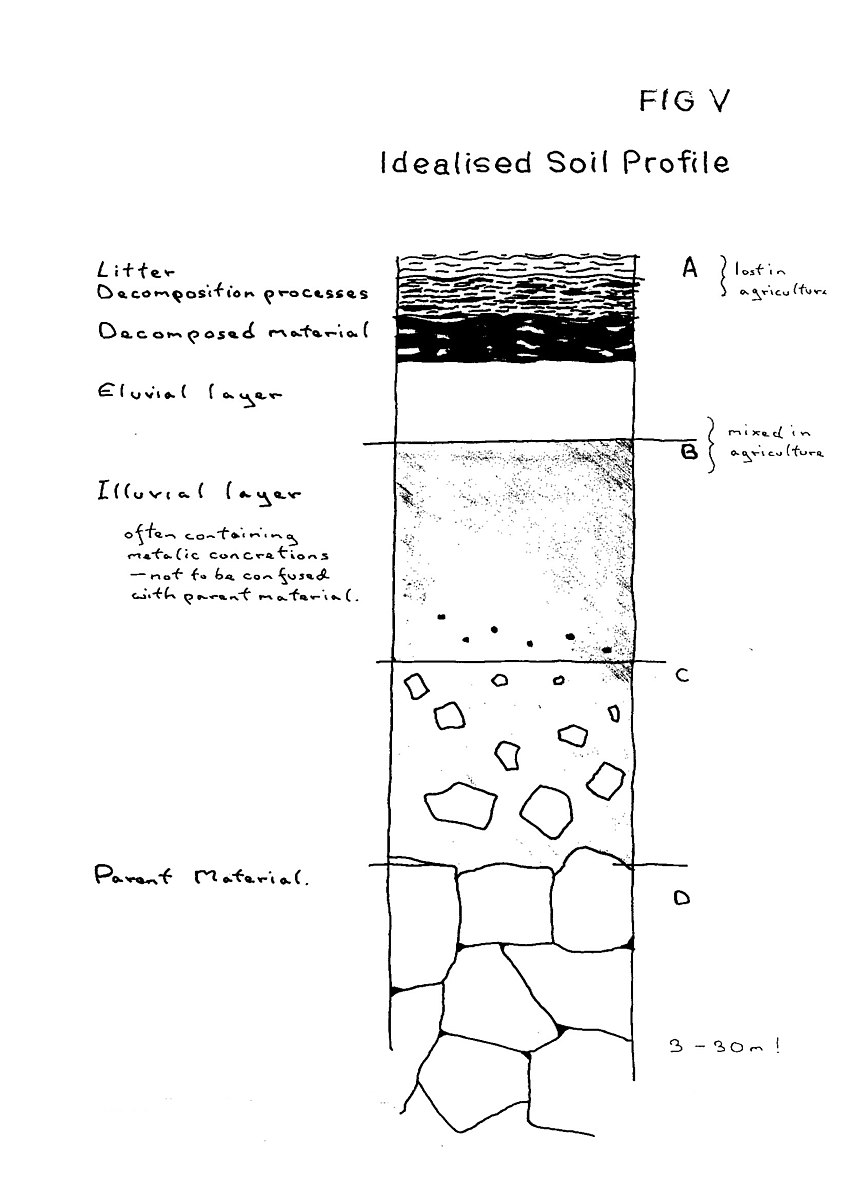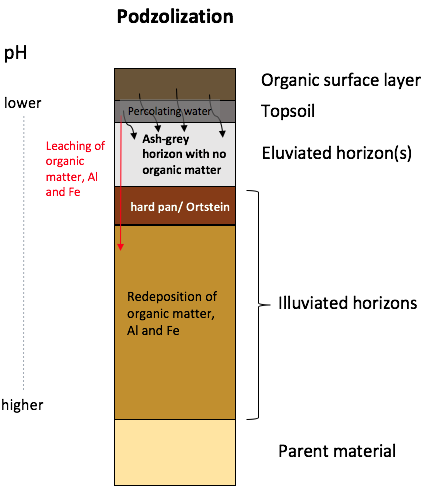Difference Between Illuviation and Eluviation

What is Illuviation?
Illuviation refers to the deposition of dissolved compounds or suspended particles into a layer or area through the movement of water. Illuviation is often discussed in the context of soil science.
Soils are more than just dirt. They are natural systems that consist of rocks, root systems, animals, and interacting layers. Soils are composed of organic matter, clays, and various minerals including evaporites and oxides. Soils are divided into horizons which represent layers with different formation histories. The surface horizons are usually rich in life and organic matter and very dynamic. Lower soil horizons tend to be more stable. These lower horizons include soils that are stained red from millions of years of weathering.
Illuviation has a significant effect on the evolution of the soil. Zones in the soil where illuviation occurs, or has occurred, are often called illuvial zones or B soil horizons. B horizons often go through significant change through the deposition of clays, organics, carbonates, and other materials.
The particles that are deposited by illuviation include clay minerals, iron, humus, and calcium carbonate. These compounds will be carried by percolating fluid, usually from precipitation. The source of illuviation is usually material leached from upper layers.
This can result in the formation of duricrusts. Duricrusts are formed by the deposition of hard materials, such as silica, alumina, and iron oxide, in a soil layer either due to illuviation or due to the minerals being residual materials from leaching. These materials are hard and will create a rock-like layer within a soil.
Many duricrusts can be understood as fossil crusts since they often represent an earlier biological, climatic, and geomorphological regime and are not currently forming in the areas where they are located. Duricrusts usually form in subtropical or intertropical regions. They are common in India, Australia, and Africa. Duricrusts have a variety of compositions. In inland basin regions, duricrusts can form from calcium carbonate or calcium sulfate evaporite deposits. Duricrusts also play an economic role in countries where they are an important source of resources, such as aluminum and manganese ores. Duricrusts also demonstrate the important environmental and economic role played by illuviation because of its importance in soil formation.

What is Eluviation?
Eluviation is the process by which material is leached out and transported from one soil layer to another soil layer by percolating fluid. The rate of eluviation is influenced by rainfall, high temperatures, and removal of protective vegetation. Soil horizons created by eluviation are classified as E horizons.
In extreme cases, eluviation can result in the elimination of all but the most insoluble materials, such as quartz, hydroxides of iron and aluminum, and iron oxides. These soils are referred to as laterites. Laterites tend to be porous and claylike. They also will have a reddish or blackish-brown color. They will have a lighter color where the soil has been freshly overturned. Laterites form where there is abundant iron-bearing rock, significant moisture for weathering, and high oxidation potential. Laterites usually occur in tropical or subtropical areas with a humid climate. Laterites also take several thousand years to form and thus require persistent climatic conditions that last for several millennia.
Laterites tend to be rich in iron oxides, but sometimes they will be rich in aluminum oxides. Aluminum-rich laterites are referred to as bauxites. Bauxites are important from an economic perspective because they are the primary source of the world’s aluminum supply. The top producers of commercial bauxite include China, India, Indonesia, and Australia. Laterites demonstrate how eluviation affects the environment and the global economy by producing certain types of soils.
Eluviation also plays an important role in ecosystems. In forests, for example, soils are important for recycling nutrients. Soils are where dead plant and other organic matter is decomposed and recycled. It is also where biological nitrogen fixation takes place through micro-organisms that produce ammonia, allowing nitrogen to be converted into a form that can be consumed by plants. Eluviation is common in forest soils where the nutrients are transported by percolating water from surface horizons into lower soil horizons. In this way, eluviation plays a role in the cycling of material necessary to sustain and nourish forest vegetation. It also plays a role in the leaching of nutrients from the soil altogether.
Similarities between illuviation and eluviation
Illuviation and eluviation are both driven by precipitation and both are important in the formation of soils. They also play an important role in the movement of organic matter and nutrients through soil which is important for life on Earth.
Differences between illuviation and eluviation
Although eluviation and illuviation are similar, there are important differences. These include the following.
- Illuviation involves the deposition of material, whereas eluviation involves the removal and transport of material.
- Illuviation is determined by the build-up of soluble minerals in layers, whereas eluviation is easier to detect from lag deposits made up of residual insoluble minerals in a layer.
- Illuviation can create dense layers, whereas eluviation tends to create porous layers.
- Illuviation can enrich a soil with nutrients, whereas eluviation can deprive a soil of nutrients.
Illuviation vs. eluviation

Summary
Illuviation refers to the buildup or deposition of dissolved minerals or suspended particles in a layer from percolating water leaching it from another layer. Illuviation can result in the creation of duricrusts which are layers in soils composed of hard minerals, such as iron oxides, alumina, and silica. Eluviation involves the removal or transport of dissolved minerals or suspended particles from one layer to another layer. Eluviation can result in the creation of crusts composed mainly of insoluble minerals that were not carried away by the percolating water. Both illuviation and eluviation are influenced by precipitation and play an important role in the creation of soils. They also differ in important ways. Illuviation involves the deposition of material, buildup of precipitated minerals, the filling of pore spaces, and the theoretical introduction of nutrients. Eluviation involves the removal of material through leaching of the soil, the creation of lag deposits of insoluble minerals, the creation of porous soil layers, and the potential removal of organic nutrients from a soil layer.
- Difference Between Environmental Performance Index and Development - November 24, 2023
- Difference Between Environmental Intervention and Development - November 8, 2023
- Difference Between Eco Efficiency and Eco Effectiveness - September 18, 2023
Search DifferenceBetween.net :
Leave a Response
References :
[0]Britannica, The Editors of Encyclopaedia. "Bauxite". Encyclopedia Britannica, 26 Jan. 2020, https://www.britannica.com/science/bauxite. Accessed 23 Mar. 2021.
[1]Doty, Lewis. “Soils and Trees.” Ecology Center, https://www.ecologycenter.us/rain-forests/soils-and-trees.html. Accessed 30 Mar. 2021.
[2]Needelman, B. A. “What Are Soils?” Nature Education Knowledge, vol. 4, no. 3, 2013, pp. 2. Library, https://www.nature.com/scitable/knowledge/library/what-are-soils-67647639/. Accessed 23 Mar. 2021.
[3]“Percolation.” European Environment Agency, n.d., https://www.eea.europa.eu/archived/archived-content-water-topic/wise-help-centre/glossary-definitions/percolation.
[4]"Soil Eluviation ." Environmental Encyclopedia. . Encyclopedia.com. 30 Mar. 2021
[5]Image credit: https://commons.wikimedia.org/wiki/File:Fig_V_Idealised_Soil_Profile.jpg
[6]Image credit: https://commons.wikimedia.org/wiki/File:Podzolization_in_Podzol_soils.png
